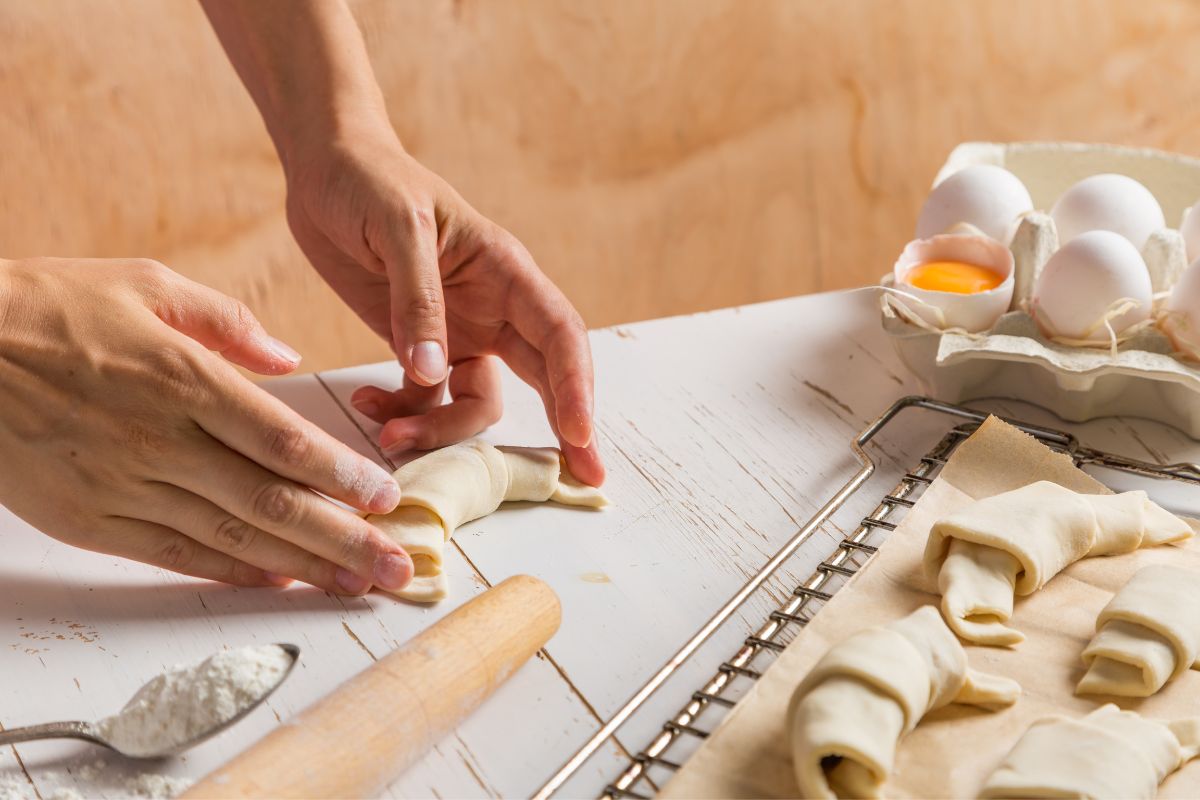Bonjour, our fellow pastry enthusiasts!
There’s nothing quite like a freshly baked, buttery croissant to make you feel like you’re sitting in a cozy Parisian café and in this article, we have an easy recipe that will yield the most delicious and flaky croissant!

While it may seem intimidating to make these flaky pastries at home, we’re here to tell you that it’s easier than you think.
With a little patience and some simple ingredients, you can achieve that perfect balance of crisp exterior and soft, pillowy interior!
Having spent years perfecting the art of French pastry, we can tell you that there’s nothing quite as satisfying as making a batch of croissants from scratch.
Not only will your kitchen smell like a dream, but you’ll also have a delicious treat to share with friends and family.
So, let’s roll up our sleeves, dust off our rolling pins, and get ready to make some mouth-watering croissants!
What Makes A Croissant Perfect
The croissant is the quintessential French pastry that has taken the world by storm. What makes them so perfect and unique?
First and foremost, croissants are known for their flaky, buttery layers.
Achieving this texture is all about the lamination process, where a block of butter is folded into the dough multiple times, creating those distinct layers.
The key here is to use high-quality butter with a high fat content, which will result in a rich and delicious pastry.
Another crucial aspect of the perfect croissant is the shaping and proofing.
Shaping the dough into the classic crescent shape takes some practice, but it’s essential to ensure that the layers are evenly distributed throughout the pastry.
Proper proofing, or allowing the dough to rise, is also crucial in achieving that light and airy texture.
Lastly, croissants are all about that delicate balance between the crispy exterior and the soft, fluffy interior.
To achieve this, the dough needs to be rolled out to just the right thickness and baked at a high temperature for a short amount of time.
This creates those beautiful golden-brown layers that shatter when you take a bite, revealing the tender and flaky interior.
Moreover, what sets croissants apart from other pastries is their complexity and attention to detail. Making the perfect croissant requires patience, skill, and a little bit of finesse. But the result is well worth the effort – a pastry that is as beautiful as it is delicious!
Now that we’ve covered the basics, it’s time to get started on making our own perfect batch of croissants. So, grab your apron and let’s get baking!
Easy Croissant Recipe
- Preparation Time: 2 hours
- Cook Time: 20 minutes
- Total Time: 2 hours 20 minutes
- Difficulty: Intermediate
- Calories per Croissant: 231 calories
Ingredients
- 250g bread flour
- 50g caster sugar
- 5g salt
- 5g instant yeast
- 120ml water
- 120ml milk
- 250g cold butter
Instructions
Step 1
In a large bowl, mix together the bread flour, caster sugar, salt, and instant yeast. Make sure to combine the ingredients thoroughly, as this will ensure that the dough rises properly.
Step 2
In a separate bowl, combine the water and milk and heat until warm. You want the liquid to be between 35-40°C to activate the yeast.
Be careful not to overheat the mixture, as this can kill the yeast.
Step 3
Add the warm liquid to the dry ingredients and stir until a dough forms. Use your hands to bring the dough together into a ball, then transfer it to a lightly floured surface.
Knead the dough for about 10 minutes, until it becomes smooth and elastic.
Step 4
After the dough has been kneaded, it’s time to start the lamination process. Roll out the dough to form a rectangle that is about twice as long as it is wide.
Place the cold butter block in the center of the dough, then fold the edges of the dough over the butter so that it is completely enclosed.
Use a rolling pin to gently flatten the dough and distribute the butter.
Step 5
Next, it’s time to start folding the dough. This will create the distinct layers that make croissants so flaky and delicious. Roll out the dough into a long rectangle, then fold it into thirds like a letter.
This is known as a single turn. Wrap the dough in plastic wrap and put it in the refrigerator to chill for at least 30 minutes.
Repeat this twice for a total of three turns, chilling the dough for 30 minutes between each one of the turns.
Step 6
After the final turn, it’s time to shape the croissants. Roll out the dough into a long rectangle that is about 3mm thick and cut it into triangles that are about 10cm wide at the base.
Use a knife to make a small slit in the center of the base, then roll up the croissant, starting at the base and rolling towards the tip.
Bend the ends of the croissant to form a crescent shape, then place the croissants on a lined baking sheet, leaving plenty of room for them to rise.
Step 7
Cover the croissants with a damp cloth and leave them to rise at room temperature for about an hour, or until they have doubled in size.
Step 8
Preheat your oven to 200°C. Beat an egg and brush the tops of the croissants with the egg wash, taking care not to brush the sides. This will give the croissants a beautiful golden sheen.
Bake the croissants in the preheated oven for 15-20 minutes, or until they are puffed and golden brown.
Step 9
Once the croissants are baked, remove them from the oven and transfer them to a wire rack for a few minutes.
Serve them warm with your favorite jams, spreads, or enjoy them plain. Croissants are best enjoyed fresh, so try to eat them within a few hours of baking.

Top Tips On How To Nail This Easy Croissant Recipe
Here are our top tips that can guarantee you the perfect croissants:
- Tip #1: Chill your dough and butter as that is key to achieving a flaky texture. Make sure to chill your dough and butter in the fridge for at least 30 minutes before rolling and folding the dough.
- Tip #2: Roll and fold the dough properly to create the signature layers in croissants. Be sure to roll the dough out into a thin, even rectangle and fold it properly according to the recipe instructions.
- Tip #3: Don’t overwork the dough when rolling and folding it, as this can cause the butter to melt and the layers to blend together. Work quickly and efficiently, and if the dough starts to feel too warm or soft, return it to the fridge to chill for a few minutes.
- Tip #4: Use a sharp knife or pastry cutter when cutting the dough into triangles to ensure clean, even cuts. This will help the croissants to bake evenly and puff up properly.
- Tip #5: Brush the croissants with an egg wash before baking to give them a beautiful golden brown color and a shiny finish.
- Tip #6: Once the croissants are baked, it’s important to allow them to cool on a wire rack for a few minutes before serving. This will help them to set and maintain their shape.
- Tip #7: Enjoy fresh! Croissants are best enjoyed fresh out of the oven, so try to eat them within a few hours of baking. If you have leftovers, you can store them in an airtight container at room temperature for up to 2 days or frozen for up to 1 month.
Can I Replace Any Of The Ingredients?
While croissants are made with a few simple ingredients, it can be difficult to substitute any of them without compromising their signature flaky, buttery texture.
For example, substituting margarine or oil for butter may result in a less rich and flavorful croissant. However, for those following a vegan or dairy-free diet, there are some butter substitutes available, such as plant-based butters or coconut oil, that can be used in place of butter.
While these substitutes may alter the flavor and texture slightly, they can still produce a delicious croissant.
Similarly, for those following a low-carb or keto diet, substituting traditional wheat flour with almond flour or coconut flour may not yield the same results as using wheat flour (if you’re looking for more things to do with almond flour, check out our guide to macarons).
These alternative flours have different properties and may result in a denser, less flaky croissant.
Nevertheless, there are some low-carb or keto-friendly croissant recipes that have been developed specifically for these diets, using a combination of almond flour, coconut flour, and other ingredients like psyllium husk and xanthan gum to mimic the texture of traditional croissants.
In general, when it comes to ingredient substitutions in baking, it’s important to keep in mind that the final product may differ from the original recipe in terms of flavor and texture.
Still, with some experimentation and creativity, it’s possible to adapt classic recipes like croissants to suit a variety of dietary needs and preferences!
Final Thoughts
Making croissants from scratch is a rewarding and satisfying experience that is sure to impress and this recipe can help you make the perfect croissants the easy way!
With a little patience and some helpful tips, you can achieve perfectly flaky and buttery croissants that rival those from a French bakery.
From properly chilling the dough and butter to rolling and folding the dough correctly, each step of the process is important to achieve the signature layers and texture of a classic croissant.
So, give this easy croissant recipe a try and let the delicious aroma of freshly baked croissants fill your home, transporting you to a quaint café in Paris!
- How To Reheat A Cheesesteak - November 5, 2023
- What Are Three Must Have Kitchen Knives? - September 22, 2023
- How To Protect Edges Of Pie Crust - June 15, 2023








